Calculus Assignment: Solutions to Problems on Rates and Functions
VerifiedAdded on 2023/01/23
|6
|1037
|48
Homework Assignment
AI Summary
This document presents solutions to a calculus assignment, addressing various problems related to rates of change, function analysis, and optimization. The solutions cover topics such as crime rate analysis, traffic speed modeling, oil production forecasting, and revenue/cost function calculations. Detailed explanations and step-by-step calculations are provided for each problem, including finding derivatives, integrals, and critical points. The assignment explores concepts like marginal cost, marginal revenue, and profit maximization in different scenarios, offering a comprehensive understanding of calculus applications in real-world situations. The problems range from analyzing crime rates to modeling airline revenue, demonstrating the versatility of calculus in diverse fields.
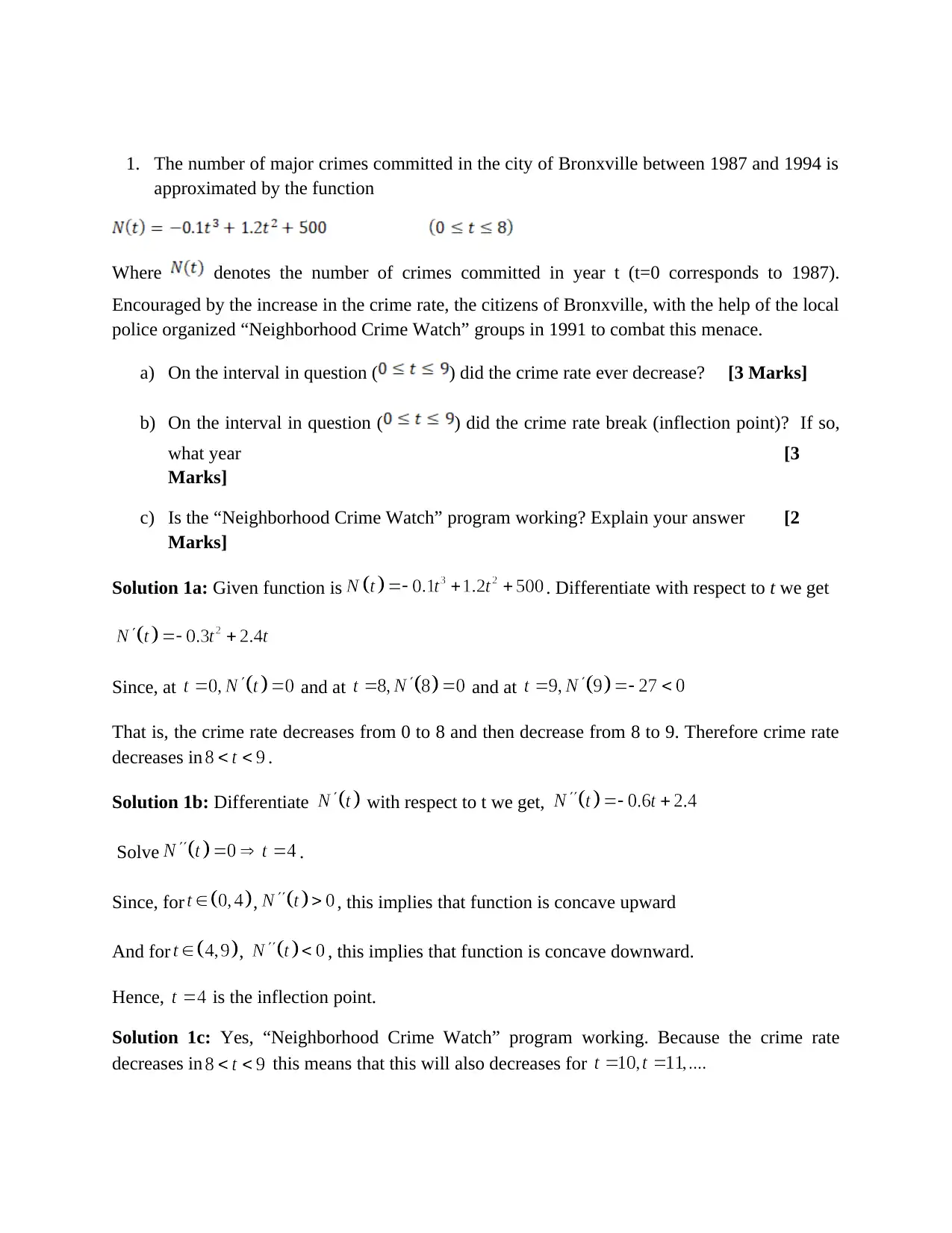
1. The number of major crimes committed in the city of Bronxville between 1987 and 1994 is
approximated by the function
Where denotes the number of crimes committed in year t (t=0 corresponds to 1987).
Encouraged by the increase in the crime rate, the citizens of Bronxville, with the help of the local
police organized “Neighborhood Crime Watch” groups in 1991 to combat this menace.
a) On the interval in question ( ) did the crime rate ever decrease? [3 Marks]
b) On the interval in question ( ) did the crime rate break (inflection point)? If so,
what year [3
Marks]
c) Is the “Neighborhood Crime Watch” program working? Explain your answer [2
Marks]
Solution 1a: Given function is . Differentiate with respect to t we get
Since, at and at and at
That is, the crime rate decreases from 0 to 8 and then decrease from 8 to 9. Therefore crime rate
decreases in .
Solution 1b: Differentiate with respect to t we get,
Solve .
Since, for , , this implies that function is concave upward
And for , , this implies that function is concave downward.
Hence, is the inflection point.
Solution 1c: Yes, “Neighborhood Crime Watch” program working. Because the crime rate
decreases in this means that this will also decreases for
approximated by the function
Where denotes the number of crimes committed in year t (t=0 corresponds to 1987).
Encouraged by the increase in the crime rate, the citizens of Bronxville, with the help of the local
police organized “Neighborhood Crime Watch” groups in 1991 to combat this menace.
a) On the interval in question ( ) did the crime rate ever decrease? [3 Marks]
b) On the interval in question ( ) did the crime rate break (inflection point)? If so,
what year [3
Marks]
c) Is the “Neighborhood Crime Watch” program working? Explain your answer [2
Marks]
Solution 1a: Given function is . Differentiate with respect to t we get
Since, at and at and at
That is, the crime rate decreases from 0 to 8 and then decrease from 8 to 9. Therefore crime rate
decreases in .
Solution 1b: Differentiate with respect to t we get,
Solve .
Since, for , , this implies that function is concave upward
And for , , this implies that function is concave downward.
Hence, is the inflection point.
Solution 1c: Yes, “Neighborhood Crime Watch” program working. Because the crime rate
decreases in this means that this will also decreases for
Paraphrase This Document
Need a fresh take? Get an instant paraphrase of this document with our AI Paraphraser
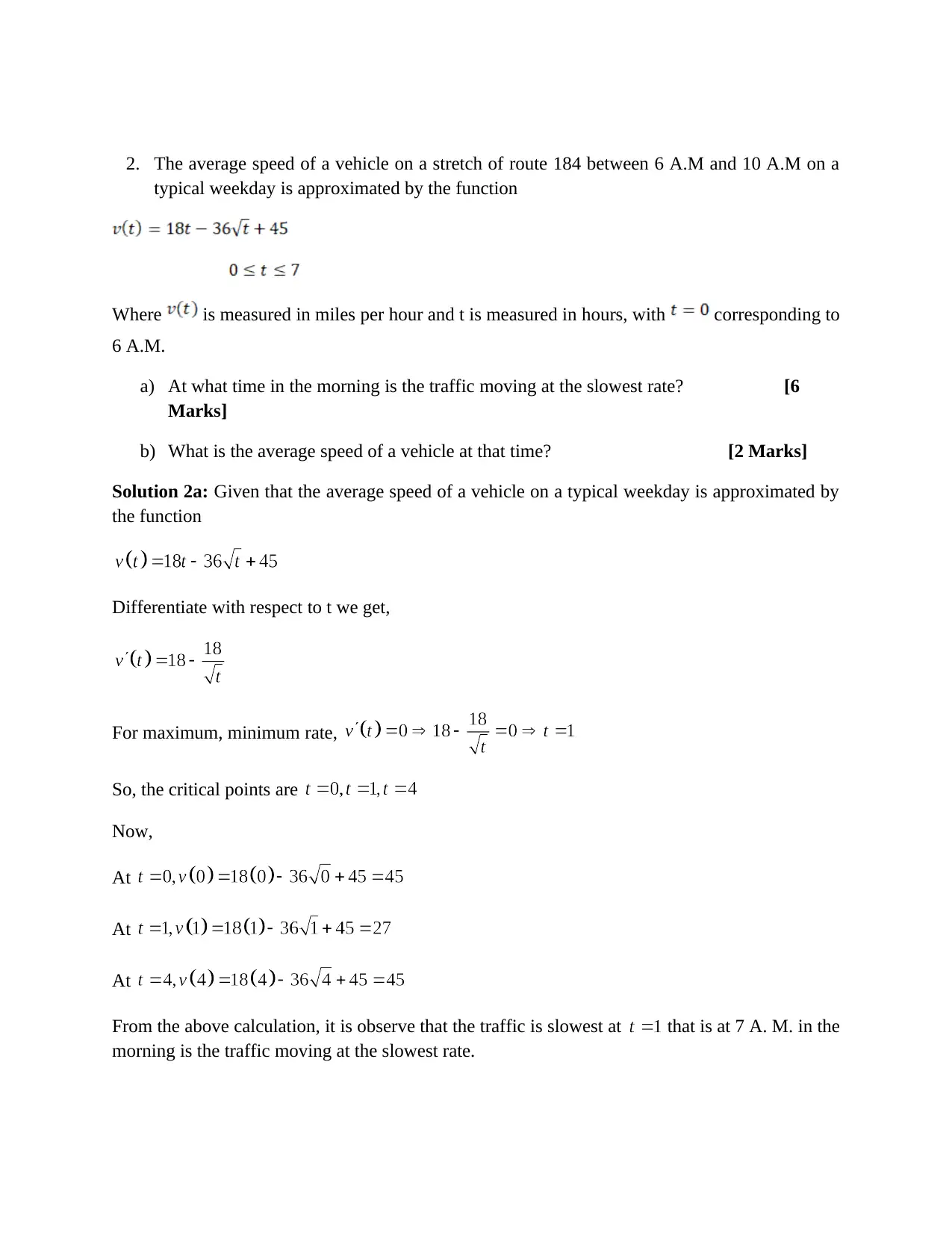
2. The average speed of a vehicle on a stretch of route 184 between 6 A.M and 10 A.M on a
typical weekday is approximated by the function
Where is measured in miles per hour and t is measured in hours, with corresponding to
6 A.M.
a) At what time in the morning is the traffic moving at the slowest rate? [6
Marks]
b) What is the average speed of a vehicle at that time? [2 Marks]
Solution 2a: Given that the average speed of a vehicle on a typical weekday is approximated by
the function
Differentiate with respect to t we get,
For maximum, minimum rate,
So, the critical points are
Now,
At
At
At
From the above calculation, it is observe that the traffic is slowest at that is at 7 A. M. in the
morning is the traffic moving at the slowest rate.
typical weekday is approximated by the function
Where is measured in miles per hour and t is measured in hours, with corresponding to
6 A.M.
a) At what time in the morning is the traffic moving at the slowest rate? [6
Marks]
b) What is the average speed of a vehicle at that time? [2 Marks]
Solution 2a: Given that the average speed of a vehicle on a typical weekday is approximated by
the function
Differentiate with respect to t we get,
For maximum, minimum rate,
So, the critical points are
Now,
At
At
At
From the above calculation, it is observe that the traffic is slowest at that is at 7 A. M. in the
morning is the traffic moving at the slowest rate.
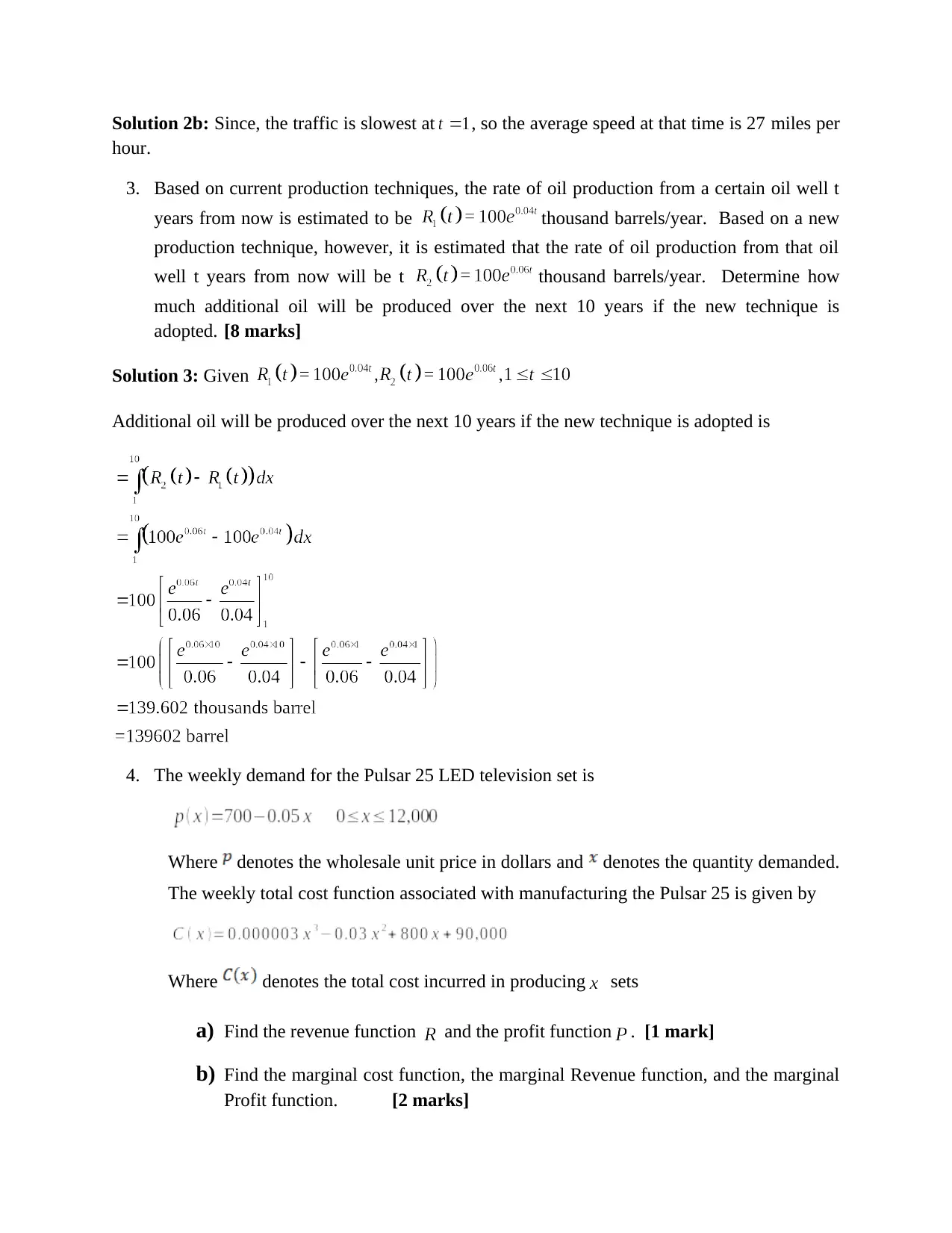
Solution 2b: Since, the traffic is slowest at , so the average speed at that time is 27 miles per
hour.
3. Based on current production techniques, the rate of oil production from a certain oil well t
years from now is estimated to be thousand barrels/year. Based on a new
production technique, however, it is estimated that the rate of oil production from that oil
well t years from now will be t thousand barrels/year. Determine how
much additional oil will be produced over the next 10 years if the new technique is
adopted. [8 marks]
Solution 3: Given
Additional oil will be produced over the next 10 years if the new technique is adopted is
4. The weekly demand for the Pulsar 25 LED television set is
Where denotes the wholesale unit price in dollars and denotes the quantity demanded.
The weekly total cost function associated with manufacturing the Pulsar 25 is given by
Where denotes the total cost incurred in producing sets
a) Find the revenue function and the profit function . [1 mark]
b) Find the marginal cost function, the marginal Revenue function, and the marginal
Profit function. [2 marks]
hour.
3. Based on current production techniques, the rate of oil production from a certain oil well t
years from now is estimated to be thousand barrels/year. Based on a new
production technique, however, it is estimated that the rate of oil production from that oil
well t years from now will be t thousand barrels/year. Determine how
much additional oil will be produced over the next 10 years if the new technique is
adopted. [8 marks]
Solution 3: Given
Additional oil will be produced over the next 10 years if the new technique is adopted is
4. The weekly demand for the Pulsar 25 LED television set is
Where denotes the wholesale unit price in dollars and denotes the quantity demanded.
The weekly total cost function associated with manufacturing the Pulsar 25 is given by
Where denotes the total cost incurred in producing sets
a) Find the revenue function and the profit function . [1 mark]
b) Find the marginal cost function, the marginal Revenue function, and the marginal
Profit function. [2 marks]
⊘ This is a preview!⊘
Do you want full access?
Subscribe today to unlock all pages.

Trusted by 1+ million students worldwide
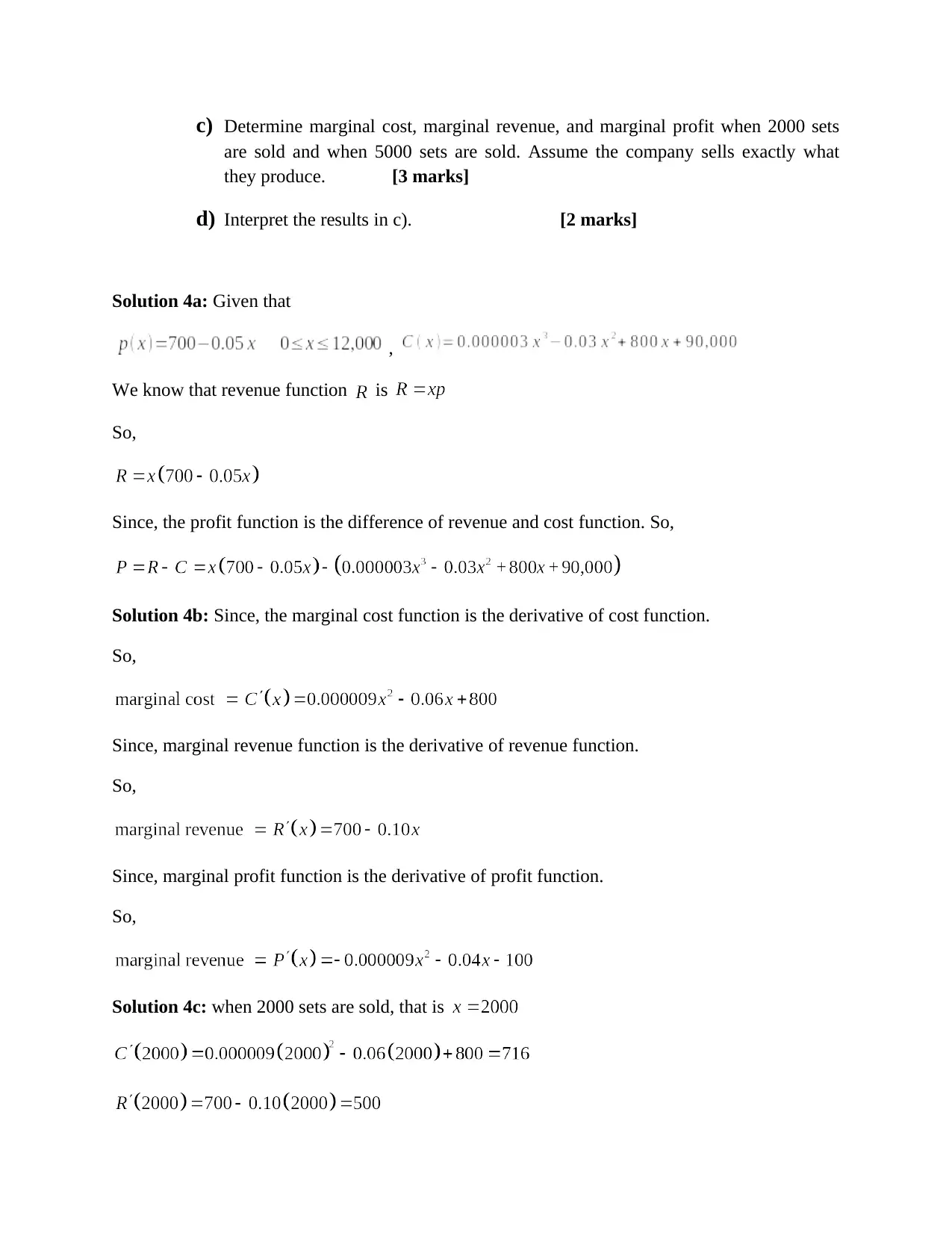
c) Determine marginal cost, marginal revenue, and marginal profit when 2000 sets
are sold and when 5000 sets are sold. Assume the company sells exactly what
they produce. [3 marks]
d) Interpret the results in c). [2 marks]
Solution 4a: Given that
,
We know that revenue function is
So,
Since, the profit function is the difference of revenue and cost function. So,
Solution 4b: Since, the marginal cost function is the derivative of cost function.
So,
Since, marginal revenue function is the derivative of revenue function.
So,
Since, marginal profit function is the derivative of profit function.
So,
Solution 4c: when 2000 sets are sold, that is
are sold and when 5000 sets are sold. Assume the company sells exactly what
they produce. [3 marks]
d) Interpret the results in c). [2 marks]
Solution 4a: Given that
,
We know that revenue function is
So,
Since, the profit function is the difference of revenue and cost function. So,
Solution 4b: Since, the marginal cost function is the derivative of cost function.
So,
Since, marginal revenue function is the derivative of revenue function.
So,
Since, marginal profit function is the derivative of profit function.
So,
Solution 4c: when 2000 sets are sold, that is
Paraphrase This Document
Need a fresh take? Get an instant paraphrase of this document with our AI Paraphraser
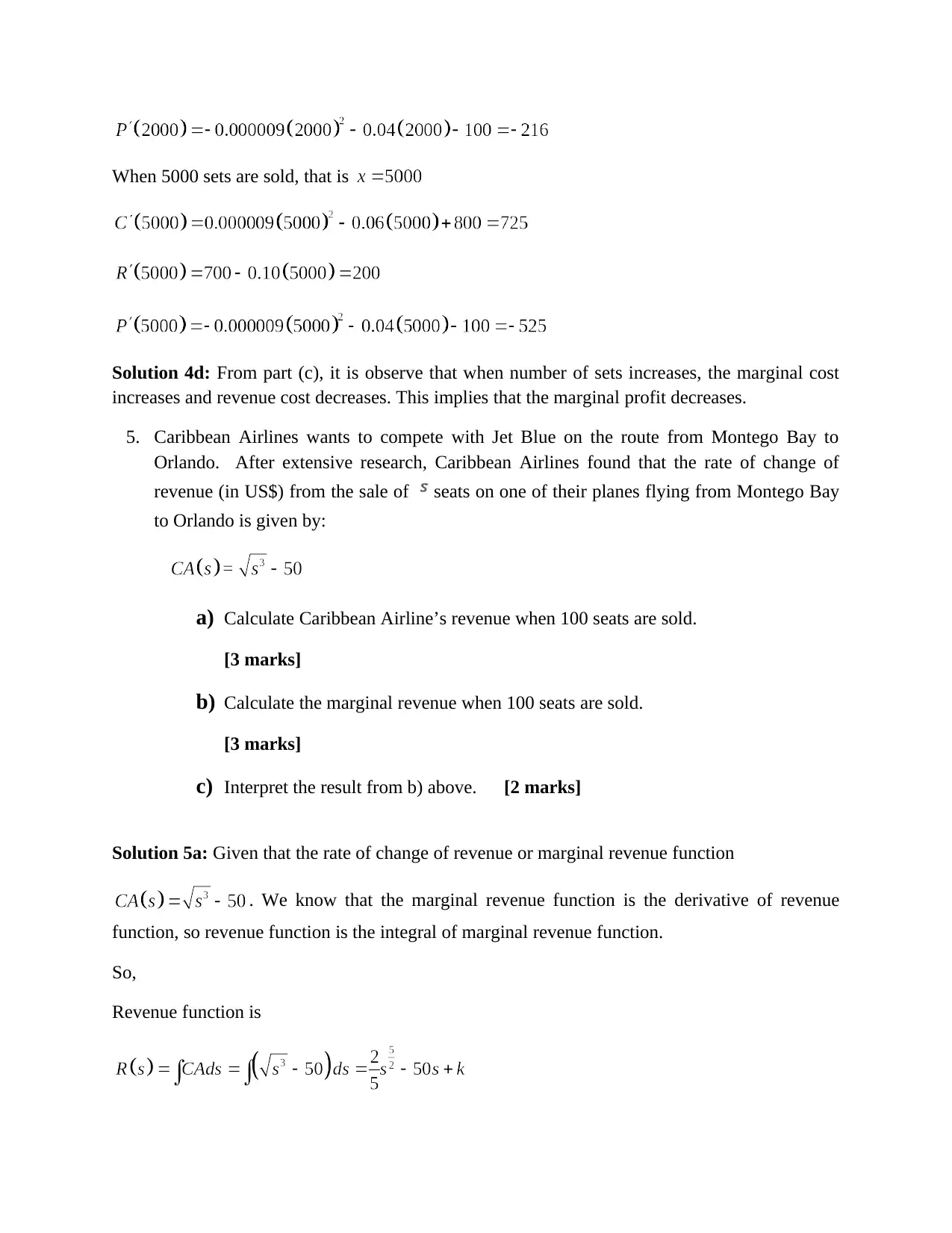
When 5000 sets are sold, that is
Solution 4d: From part (c), it is observe that when number of sets increases, the marginal cost
increases and revenue cost decreases. This implies that the marginal profit decreases.
5. Caribbean Airlines wants to compete with Jet Blue on the route from Montego Bay to
Orlando. After extensive research, Caribbean Airlines found that the rate of change of
revenue (in US$) from the sale of seats on one of their planes flying from Montego Bay
to Orlando is given by:
a) Calculate Caribbean Airline’s revenue when 100 seats are sold.
[3 marks]
b) Calculate the marginal revenue when 100 seats are sold.
[3 marks]
c) Interpret the result from b) above. [2 marks]
Solution 5a: Given that the rate of change of revenue or marginal revenue function
. We know that the marginal revenue function is the derivative of revenue
function, so revenue function is the integral of marginal revenue function.
So,
Revenue function is
Solution 4d: From part (c), it is observe that when number of sets increases, the marginal cost
increases and revenue cost decreases. This implies that the marginal profit decreases.
5. Caribbean Airlines wants to compete with Jet Blue on the route from Montego Bay to
Orlando. After extensive research, Caribbean Airlines found that the rate of change of
revenue (in US$) from the sale of seats on one of their planes flying from Montego Bay
to Orlando is given by:
a) Calculate Caribbean Airline’s revenue when 100 seats are sold.
[3 marks]
b) Calculate the marginal revenue when 100 seats are sold.
[3 marks]
c) Interpret the result from b) above. [2 marks]
Solution 5a: Given that the rate of change of revenue or marginal revenue function
. We know that the marginal revenue function is the derivative of revenue
function, so revenue function is the integral of marginal revenue function.
So,
Revenue function is
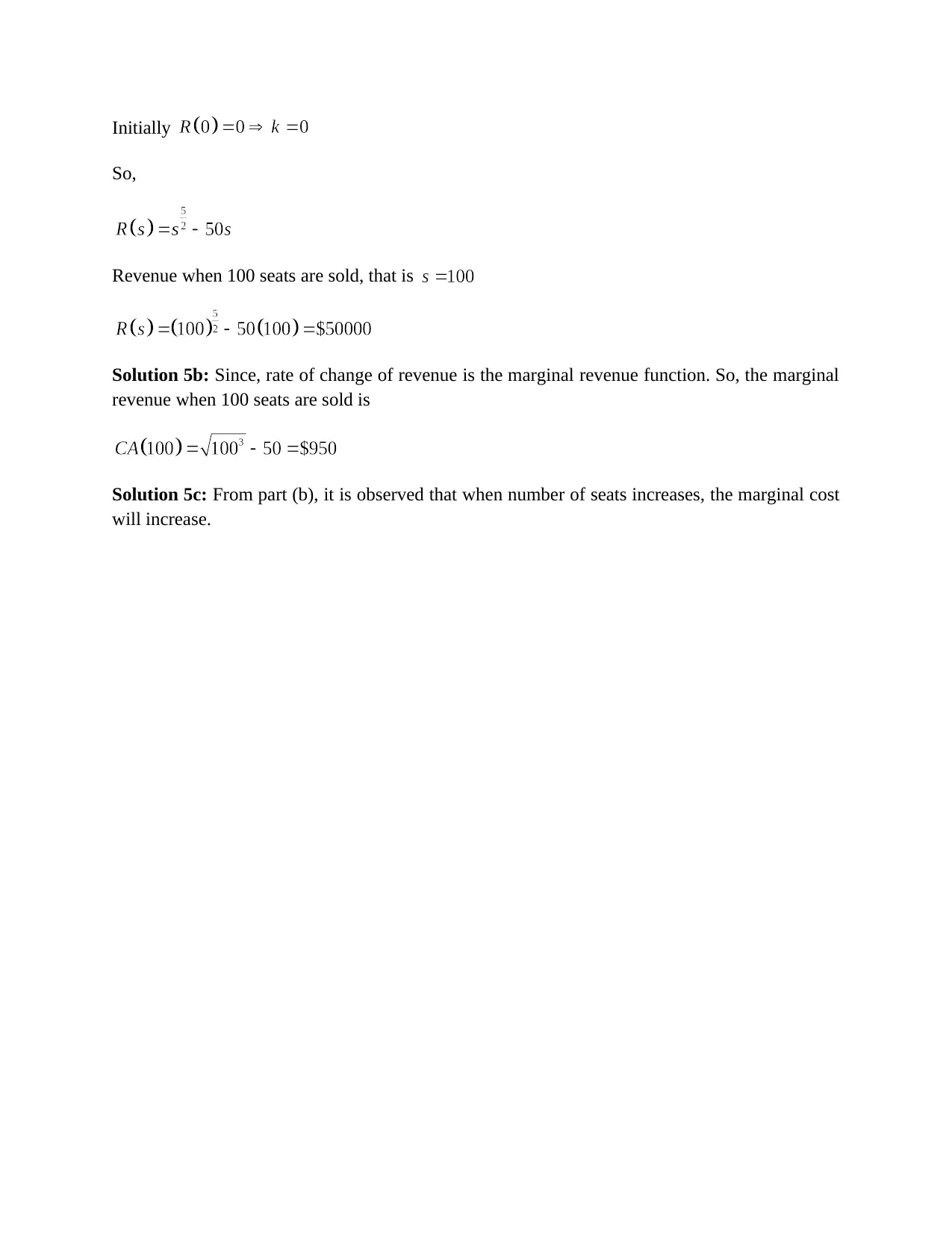
Initially
So,
Revenue when 100 seats are sold, that is
Solution 5b: Since, rate of change of revenue is the marginal revenue function. So, the marginal
revenue when 100 seats are sold is
Solution 5c: From part (b), it is observed that when number of seats increases, the marginal cost
will increase.
So,
Revenue when 100 seats are sold, that is
Solution 5b: Since, rate of change of revenue is the marginal revenue function. So, the marginal
revenue when 100 seats are sold is
Solution 5c: From part (b), it is observed that when number of seats increases, the marginal cost
will increase.
⊘ This is a preview!⊘
Do you want full access?
Subscribe today to unlock all pages.

Trusted by 1+ million students worldwide
1 out of 6
Your All-in-One AI-Powered Toolkit for Academic Success.
+13062052269
info@desklib.com
Available 24*7 on WhatsApp / Email
![[object Object]](/_next/static/media/star-bottom.7253800d.svg)
Unlock your academic potential
Copyright © 2020–2025 A2Z Services. All Rights Reserved. Developed and managed by ZUCOL.